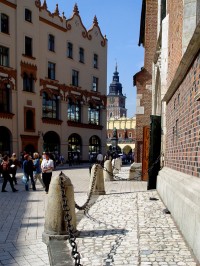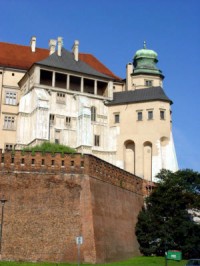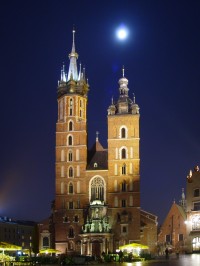When I first visited Krakow, I didn’t know what to expect. I knew that the city is one of the few Polish cities not destroyed during WWII and that the beautiful architecture of its buildings is some of the oldest in Poland. I also knew that Krakow has the largest medieval town square in all of Europe, the Main Market Square.  Finally, I knew that Polish beer—piwo in Polish, pronounced ‘pee-voh‘—is some of the best in Europe. What I didn’t know, was that Krakow has a vibrancy to it that makes it one of the most romantic cities in all of Europe.
Finally, I knew that Polish beer—piwo in Polish, pronounced ‘pee-voh‘—is some of the best in Europe. What I didn’t know, was that Krakow has a vibrancy to it that makes it one of the most romantic cities in all of Europe.
Upon arrival, my traveling partners and I found ourselves in the massive Main Market Square. With a long row of market stands in the center, the towering spiral of Wawel Cathedral in one corner, flowing fountains, and open-air café s on every side, the square provides a pleasant juxtaposition of medieval and modern. Like all squares, it was filled with pigeons. And when the horse and carriage taxis come through, all of the birds arose en mass, making for a dramatic atmosphere.
 After dropping off my things, I visited the Wawel Castle, which is located near the center of Krakow beside the Vistula River. The castle was built during the 16th Century and is now a National Museum. The courtyard provides a stunning look at the castle’s ancient architecture and touring the castle’s walls and turrets provides unparalleled views of Krakow.
After dropping off my things, I visited the Wawel Castle, which is located near the center of Krakow beside the Vistula River. The castle was built during the 16th Century and is now a National Museum. The courtyard provides a stunning look at the castle’s ancient architecture and touring the castle’s walls and turrets provides unparalleled views of Krakow.
One of the castle’s passageways takes visitors underground and drops them off along the river. The river winds gently through Krakow with city parks lining most of the river banks, making for a great place to picnic or share a bottle of wine (drinking in public is legal in Poland, as in most European countries).
 As the sun set, I returned to the Main Market Square. I grabbed a table at a café and ordered a glass of my favorite Polish beer, Okocim Mocne (mocne means strong, viz. high in alcohol content). The square was still filled with horse-drawn carriages charging through flocks of pigeons. While I observed well-dressed couples walk arm in arm in the evening glow, I heard the distintive sound of a bugle emanate from the Wawel Cathedral.
As the sun set, I returned to the Main Market Square. I grabbed a table at a café and ordered a glass of my favorite Polish beer, Okocim Mocne (mocne means strong, viz. high in alcohol content). The square was still filled with horse-drawn carriages charging through flocks of pigeons. While I observed well-dressed couples walk arm in arm in the evening glow, I heard the distintive sound of a bugle emanate from the Wawel Cathedral.
Every hour, on the hour, a bugle is played from high in the spire of the Wawel Cathedral. The song lasts anywhere from 15 seconds to 2 minutes, and reflects the mood of the bugler. At 6pm, the tune was lively and boastful. Later that night, I walked through the Main Market Square at 1 or 2am. The square was deserted except for two lovers sitting around the fountain. As I was about to make my way back to my hotel, the bugle again sounded. The song was perfect for the occasion—a soft tune full of longing. It seemed to embody the centuries and centuries of feelings of yearning in the ancient city of Krakow.


Comments